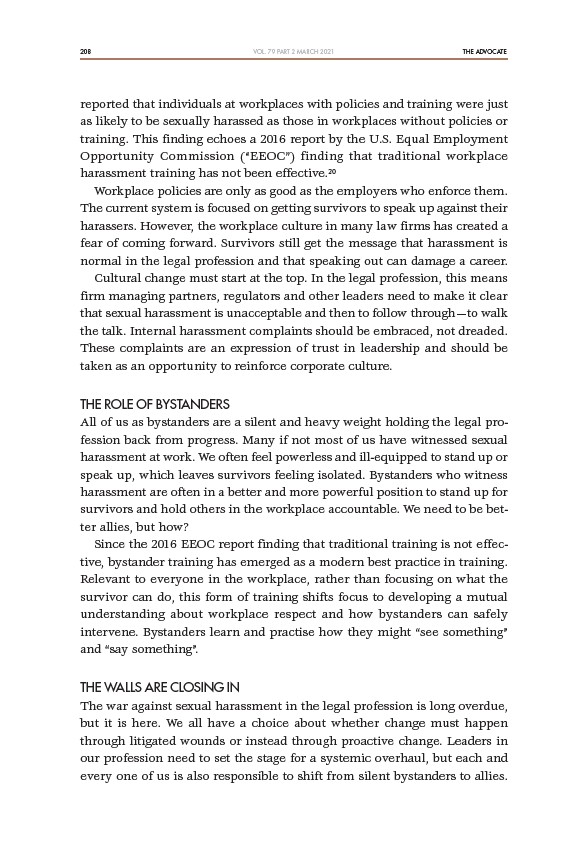
208 THE ADVOCATE
VOL. 79 PART 2 MARCH 2021
reported that individuals at workplaces with policies and training were just
as likely to be sexually harassed as those in workplaces without policies or
training. This finding echoes a 2016 report by the U.S. Equal Employment
Opportunity Commission (“EEOC”) finding that traditional workplace
harassment training has not been effective.20
Workplace policies are only as good as the employers who enforce them.
The current system is focused on getting survivors to speak up against their
harassers. However, the workplace culture in many law firms has created a
fear of coming forward. Survivors still get the message that harassment is
normal in the legal profession and that speaking out can damage a career.
Cultural change must start at the top. In the legal profession, this means
firm managing partners, regulators and other leaders need to make it clear
that sexual harassment is unacceptable and then to follow through—to walk
the talk. Internal harassment complaints should be embraced, not dreaded.
These complaints are an expression of trust in leadership and should be
taken as an opportunity to reinforce corporate culture.
THE ROLE OF BYSTANDERS
All of us as bystanders are a silent and heavy weight holding the legal profession
back from progress. Many if not most of us have witnessed sexual
harassment at work. We often feel powerless and ill-equipped to stand up or
speak up, which leaves survivors feeling isolated. Bystanders who witness
harassment are often in a better and more powerful position to stand up for
survivors and hold others in the workplace accountable. We need to be better
allies, but how?
Since the 2016 EEOC report finding that traditional training is not effective,
bystander training has emerged as a modern best practice in training.
Relevant to everyone in the workplace, rather than focusing on what the
survivor can do, this form of training shifts focus to developing a mutual
understanding about workplace respect and how bystanders can safely
intervene. Bystanders learn and practise how they might “see something”
and “say something”.
THE WALLS ARE CLOSING IN
The war against sexual harassment in the legal profession is long overdue,
but it is here. We all have a choice about whether change must happen
through litigated wounds or instead through proactive change. Leaders in
our profession need to set the stage for a systemic overhaul, but each and
every one of us is also responsible to shift from silent bystanders to allies.